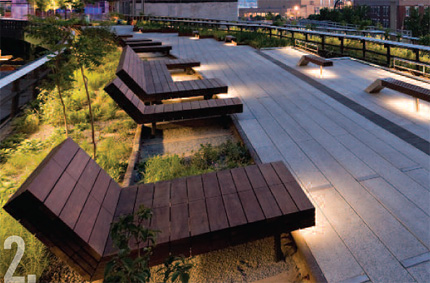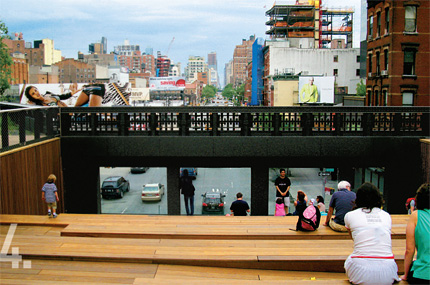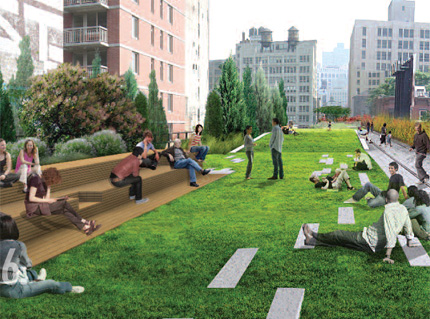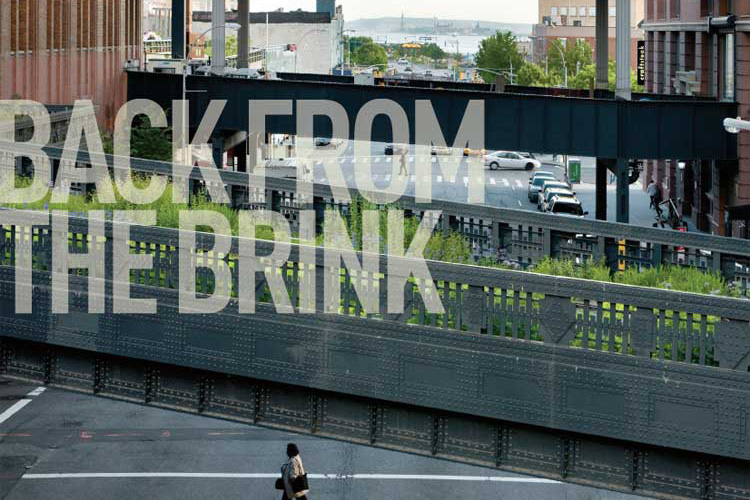Once slated for demolition, the High Line is born again—thanks to a perfect storm of public will, private interests, and (uncharacteristic) city cooperation
by Jill Hamburg Coplan
In the spring of 2001,writer Adam Gopnik (IFA ’84) climbed 30 feet up onto a derelict freight railway, tucked mostly out of sight between 10th and 11th avenues. He began near its northern terminus at 34th Street, sliding under a chain-link fence and skirting a wild glade of ailanthus trees growing between the rails. Farther south he found a junkyard and a homeless encampment. He was following photographer Joel Sternfeld, who was recording four seasons of shifting moods on the viaduct, which had become, after 20-odd years of disuse and decay, an accidental meadow in the sky.
In “A Walk on the High Line,” published in The New Yorker with Sternfeld’s photos that May, Gopnik wrote that the space “combines the appeal of those fantasies in which New York has returned to the wild with an almost Zen quality of measured, peaceful distance.” The magazine piece would be, it seemed, the High Line’s eulogy—though he did note in passing that some local preservationists hoped to turn the structure into a park. The idea “seemed to me both completely quixotic and wonderfully bold,” Gopnik says today. “I also thought: It doesn’t stand a chance of ever happening.”
Gopnik’s story, it turned out, was just the broadsheet that advocates needed to make their case. The article was the first improbable turning point in the creation of New York’s newest icon—one of the boldest reinventions in a city constantly reinventing itself. Set to celebrate its first anniversary in June 2010, the High Line has been drawing crowds of as many as 25,000 people a day since it opened as a public park. Resurrected by a who’s who of global design and landscaping luminaries, the space has been lauded in newspapers and magazines from Turkey to Argentina, and beyond. On a recent Sunday afternoon, Korean landscape design students admired the river, a yogi in red stripes did sun salutations, and an elderly couple chatted in German. Amid the hoopla, it’s easy to forget that the space was once slated for destruction.
The 1.5-mile High Line hugs the West Side, from Gansevoort Street up to a fishhook swing around the West Side Rail Yards at 34th Street. Built in the early 1930s by the New York Central Railroad, it rolls in places inside warehouses and factories, where trains shunted milk, livestock, produce, and other goods. It replaced a street train that collided so often with traffic that 10th Avenue was once nicknamed Death Avenue. In 1980, its last delivery was three carloads of frozen turkeys. With time and neglect, Chelsea landlords called the trestle a blight and Mayor Rudy Giuliani’s administration condemned it to be torn down. Had Conrail (later CSX) and the city not been deadlocked over who’d pay the millions for removal, it would have been demolished long ago.
Its survival is a credit to the visionaries who saw a possibility that was far from obvious, as well as the unusual alignment of commercial interests, city government, and the foundation sector, which found common cause in the healing process following September 11. Joshua David, a writer, and Robert Hammond, a painter, formed Friends of the High Line in 1999 but got little notice until Gopnik’s article, and later, the terror attacks, brought attention and a change in perspective. New Yorkers wanted to help the wounded lower West Side. Michael Bloomberg’s election soon after marked the next turning point, as advocates released feasibility studies proving that the park would create enough new tax revenue to pay for itself. Just like that, the mayor and a growing circle of politicians got on board.
In one of Bloomberg’s early acts after taking office in 2002, City Hall proposed that the High Line be designated a federal rails-to-trails park under a 20-year-old act that’s converted 15,000 miles of U.S. railroad into recreational space. Soon, the High Line became the centerpiece of the administration’s plans for reviving the West Side and caught fire with Congressional reps, state legislators in Albany, and corporate donors and celebrities including actor Kevin Bacon, whose father was a Philadelphia urban planner. Clothing designer Diane von Furstenburg and her husband, NYU Trustee Barry Diller, donated $5 million early on; Diller also commissioned Frank Gehry to design his IAC/InterActiveCorp company headquarters beside the railroad. It took four more years for the park project to weave through a bureaucratic maze before, in spring 2006, ground was broken.
Part of the credit for putting the High Line on this relatively fast track should go to NYC Planning Commissioner Amanda Burden. An early advocate of the project, Burden helped devise a plan that won the support of certain building owners by allowing them to erect structures larger than the neighborhood limit. Adrian Benepe, commissioner of the NYC Parks and Recreation Department, believes that this was a key driver of the process, noting the irony of Giuliani’s original desire to demolish the rails because they were blocking real development. Mitchell Moss, Henry Hart Rice Professor of Urban Policy and Planning at the Robert F. Wagner Graduate School of Public Service, calls the mass effort a “remarkable convergence” of skilled activists, and an enthusiastic mayor, planning commissioner, and city council who all envisioned a project that would somehow benefit every interest involved. In the scheme of New York undertakings, Moss says, “this was really one of a kind.”
Architects flocked to it: Some 720 teams entered a design contest run by the city. The winners were marquee names: James Corner Field Operations (now heading up the transformation of Fresh Kills landfill into a park) and Diller Scofidio + Renfro (master planners for Governors Island Park and the new Lincoln Center redesign). A dozen-plus firms were picked for engineering, lighting, soil science, and irrigation. Tracks and rails were removed, tagged, and stored; steel and cement were sandblasted, waterproofed, and repaired. Then came constructing stairs, ramps, elevators, and installing drainage, paths, an amphitheater, hundreds of plant species, seating, and LED lighting. Section 1 (Gansevoort to 20th Street) cost $86 million, and Section 2 (20th to 30th Street), which will open later this year, came in at $66 million, says Katie Lorah (GAL ’05), spokesperson for Friends of the High Line.
Today, the tough grasses that poke through walkways, the rugged geometry of old rivets, and the metallic stairs pay tribute to the clang of bygone industry. Bits of salvaged rail peek through drifts of perennials. Visitors may be easily enchanted by the High Line, but architecture critics have also sung its praises, comparing the meandering path to Rome’s Appian Way, Victorian and Japanese stroll gardens, Italian futurist visions of floating trains, and even the elevated cable cars of Sam Raimi’s Spider-Man. Part of the charm can be attributed to its unique height, says Hilary Ballon, University Professor of Urban Studies and Architecture at Wagner. “We have street-level views and we have skyline views, but this third-story view, which slices through the city, is exciting and different,” she notes.
Creating public parks with an eye on real estate and commercial benefits is not a new concept. Green spaces have inspired urban renewal in New York since the Parks Department was created in 1870, Ballon says. Even with the heavy economic recession, the High Line has already triggered 33 developments, from housing (500 units, with 800 more planned) to hotels, Commissioner Burden says. In October, the Whitney Museum of American Art announced that it was buying a city-owned meatpacking plant on Gansevoort Street for a new downtown satellite building by star architect Renzo Piano. It will join other high-profile edifices in the High Line’s shadow—including Gehry’s and one recently designed by Jean Nouvel.
Renewal was on city planners’ minds when they fit the High Line, puzzle-like, into the rezoning of the warehouse and manufacturing district, explains James Stuckey, divisional dean of the NYU Schack Institute of Real Estate at the School of Continuing and Professional Studies. A longtime developer of private-public endeavors, Stuckey gave the High Line official approval in stages, from 2004-07, as president of the New York City Public Design Commission. The goal was saving the “viewscape,” he says, so even as the complicated viaduct wends between and through old structures, no new buildings obstruct sightlines, either toward the city or the Hudson River. “Preserving the structure created a unique open area that would otherwise have been covered by the canyon effect,” Stuckey explains.
Planners hope that the High Line will eventually work its magic north from 30th to 34th Street, though that stretch is still owned by CSX. In March 2010, the first hurdle was cleared as Midtown’s Community Board 4 voted in favor of allowing the city to acquire the remaining platform. The High Line there is soot-blackened, draped in barbed wire, and surrounded by construction sites, but planners would like this last, undeveloped corner of Manhattan to become a corridor of offices and apartment towers linked with Chelsea. A flowering High Line would anchor it all.
The High Line’s success has already inspired other cities to imagine repurposing their aging civil engineering. Movements are afoot to reclaim railways for parkland at the Reading Terminal viaduct in Philadelphia, the Bloomingdale Trail in Chicago, the BeltLine in Atlanta, and the Harsimus Stem Embankment in Jersey City. The “quixotic” idea that Gopnik noted in his New Yorker piece actually proved to be quite practical. “It’s a model for reusing any old infrastructure for the public’s benefit,” Stuckey says.
Today Gopnik, who’s authored two best-selling memoirs, is delighted and amazed at the small role that his story played. His son, who was a little boy when he wrote the piece, is now 15 and spends countless hours on the High Line with his friends. “They use it the way Italian 15-year-olds use a piazza,” Gopnik says. “They go strolling, I imagine talk to girls, and have their lunch. I thought it might be a lonesome place, but it’s crowded with people. It filled a need we didn’t even know we had.”

1.
Gansevoort Stairs
At the High Line’s southern end, where Gansevoort and Washington streets meet, a glass-walled steel-and-aluminum staircase is cut into the structure, exposing its giant beams. Up top, the overlook offers
a window onto the Meatpacking District, and nearby is a mini forest reminiscent of the ailanthus groves that sprouted here (though as an aggressive invader, it hasn’t been planted).

2.
Sundeck
Above 14th Street is
a popular hangout: a wooden sundeck with dark hardwood benches and chaise lounges facing the Hudson River. Set on wheels, the seats roll along the rails and are coveted spots on sunny days and at sunset.

3.
Chelsea Market Passage
The High Line railroad once passed inside warehouses, including the Chelsea Market, to make deliveries. One loading dock is now an airy tunnel where a wall of factory windows has turned public art in Spencer Finch’s The River That Flows Both Ways, 700 panes of glass stained the many colors of water and drawn from photos the Brooklyn artist took of the Hudson.

4.
10th Avenue Square
At 17th Street, a wooden amphitheater is suspended vertiginously above the middle of 10th Avenue. The view allows visitors an unobstructed gaze both uptown and down to the Statue of Liberty. At night, soft LED lighting, at waist level or lower, avoids upstaging the sky and city lights.

5.
Chelsea Grasslands
Around 18th Street, the Empire State Building comes into view and an urban prairie flourishes. The fashionably unkempt style uses tough, low-maintenance grasses and perennials to evoke the untamed meadow described in the New Yorker story. Hundreds of species of sedges, catmints, and coneflowers, among others, mound in the hot months and die back in winter. The long cement planks of the path are tapered, like fingers, allowing plants to fill the gaps and overgrow remnants of the original rails.

6.
Northern Terminus
Section 1 ends at 20th Street, though work is proceeding on Section 2, which will extend to 30th Street. Plants go into the soil this spring, and the viaduct will be painted a fresh green. As shown in the rendering above, the High Line is narrower here—30 versus 60 feet wide to the south—and straighter, but it, too, will have distinctive architectural features, such as a glass-bottomed bridge.








